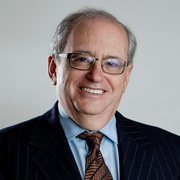
An Army captain visits a Vietnam War veteran at a VA hospital in Nashville, Tn., on November 5, 2012. U.S. Army photo by Capt. Xeriqua Garfinkel, 159th Combat Aviation Brigade Public Affairs
Lessons of the VA Scandal
The VA needs a skilled executive much more than it needs a decorated soldier -- and 9 other takeaways from the recent scandal that rocked the department. By Norm Ornstein
What are we to make of the VA?
Over the past few weeks, I have read a lot about the scandal and the overall story surrounding the agency (it is actually the Veterans Affairs Department and the Veterans Health Administration, but we will call both the VA for short). I have tried to make sense of what is real, and what lessons we can learn. Here are my conclusions.
1. There clearly is a scandal here, not a faux one like the IRS or Benghazi. There were at least some malevolent actors, who created an elaborate system to cover up the delays in scheduling doctor visits for veterans, in Phoenix and other places. And these actors were enabled by lots of other VA employees, who either succumbed to intimidation or wanted to avoid internal hassles. Some of the miscreants benefited financially from their wrongdoing; whether the reason for the cover-up was financial gain or avoidance of embarrassment, demotion, or sanction does not really matter.
2. The root of the problem—i.e., the long delays between appointments requested and doctor or nurse visits received—was not in the cover-up plan. It was in the stark mismatch between demand and supply, between the surge in veterans seeking medical care through the VA and the supply of doctors and nurses to care for them. The surge during the Obama administration occurred for several reasons. One was the highly commendable effort by the administration to open up care to more veterans; the second was the sharp increase in demand from returning veterans from Iraq and Afghanistan. Plus, there are these relentless demographic realities: The remaining veterans from World War II and Korea required more care as they got older, and there has been an increase in the number of middle-aged and older veterans from the Vietnam era.
3. The shortage of doctors and other medical professionals is not just a problem at the VA, but is society-wide. We face a physician shortage that will grow more acute as the Affordable Care Act achieves its goals of more Americans covered and more of them seeking care. Lots of other things are contributing to the doctor shortage, including soaring costs of medical education and lower compensation for physicians, along with immigration issues that are reducing the supply over time of foreign-born medical professionals. Wait times in the private sector are nothing to write home about. But the problem is worse for the VA, which cannot easily compete with the private sector for doctors in terms of either pay or benefits. And, of course, the problem has fed on itself in two ways. One is that fewer doctors and more patients lead to more workload and more pressure on doctors, inducing many to quit. A second is that the way the VA has been administered—including via a management culture that precipitated the dishonesty and scandal—has added to the frustration of doctors inside the system.
4. As many inside and outside the system point out, care at the VA—as opposed to getting appointments to get care—is outstanding and highly regarded by veterans who receive it. By many standards, it is better than that provided in most places in the private sector. A main reason for this, which I have seen first-hand in the VA care provided to my father-in-law, a World War II veteran, is that the care is holistic. In the private sector, one can see a cardiologist, a urologist, an internist, a gastroenterologist, etc., with each prescribing medications and diagnosing problems with little or no contact or coordination among them, with no one to see the forest for the trees or to monitor drug interactions. At the VA, doctors communicate and interact much more.
5. While the VA has seen a significant increase in its funding over the past several years, it is still very much underfunded—and much of the money going to the VA is misallocated, making the problems worse. As Peter Schuck has pointed out, the root of this problem is more with Congress than anyone else. Congress has jumped whenever veterans' groups say so, and that has included defining disabilities that can receive compensation far more broadly and generously than is affordable. This has left the agency swamped with claims. When people inside the VA pointed out that we now have 150,000 veterans receiving bundles of money for sleep apnea—not exactly a service-related disability—Congress shrugged. That is money that could be spent dealing with real and deep problems. When Congress tried to create new medical centers to respond to the demand, Republicans in Congress refused to fund them. Congress has created the rules that make it virtually impossible to fire or discipline employees—not just a VA problem, of course—and has failed to do the kind of vigorous oversight that would have uncovered these problems much earlier, and resulted in congressional actions.
6. The endemic and systemic problems in the VA go back decades. Presidents from George H.W. Bush on have struggled to bring functionality to the VA, both when it was an agency and after it became a Cabinet department. Some presidents, notably Bill Clinton, did better than others, but none succeeded in creating an agency that worked smoothly and well. Of course, the failure to coordinate between the Defense Department and the VA over care for current and former military personnel, along with the sharp increase in veterans requiring complex care for physical and mental injuries and traumas, has not helped. But neither has the relative indifference of administrations, including Obama's, or the failure, government-wide, to modernize information technology, which itself is at the root of many of the VA's health and disability system problems.
7. The problems are there in significant part because of the size and complexity of the agency and the problems it is supposed to ameliorate. As Phillip Carter pointed out in Slate, "The VA is the second-largest Cabinet agency, and the nation's largest health care and benefits provider, with an overall fiscal 2015 budget of $165 billion (greater than the State Department, USAID, and entire intelligence community combined), including $60 billion for health care. The VA employs more than 320,000 personnel to run 151 major medical centers, 820 outpatient clinics, 300 storefront 'Vet Centers,' more than 50 regional benefits offices, and scores of other facilities. This massive system provides health care to roughly 9 million enrolled veterans, including 6 million who seek care on a regular basis."
8. General Eric Shinseki was neither the cause nor the perpetrator of this. He had flaws. He was too passive in his public performance, did not show enough indignation when he became aware of the problems, or push Congress strongly enough for the resources he needed. He was too trusting of his subordinates (although it is now clear he did not sit in his ivory tower, but traveled regularly to VA sites, interviewing employees and imploring them to be honest with him). His problem, as a military man, was the same as the one Dwight Eisenhower faced when he moved from general to president; as Harry Truman pointed out: "Poor Ike, he is used to saying, 'Do this, do that,' and actually having it happen." Shinseki also had many strengths, and he did some remarkable and positive things for homeless veterans and many others. Given the nature of modern politics and media, where politicians and pundits call for heads to roll and journalists cover the bloodsport far more than the real problems, it was inevitable that he would resign. But it was not very fair and does not solve much of anything.
9. There is an immediate problem requiring triage, and a longer-term set of issues to deal with.Privatizing the VA, given its high quality of care and focus on the unique problems of veterans, may sound good, but it is foolish. The VA does need more money, and more flexibility from Congress to allocate it to fix the problems. But it makes immediate sense to give veterans who cannot get appointments for care or consultation on a timely basis temporary Medicare cards to find providers now until the wait times can actually be reduced. More broadly, we must take a truly serious look at civil-service rules and a concerted effort, perhaps led by top tech professionals outside government, to find appropriate ways to create 21st century information systems. And we need a better way to attract and keep medical professionals, and technical experts, in government. Multiyear pay freezes and blanket denial of bonuses is not the answer.
10. It is far more important to get a good executive, a top administrator, to head the VA then it is to get a decorated veteran. The VA needs someone who knows something about health delivery but even more about how bureaucracies work and how to work with, or navigate around, Congress. The VA needs someone who knows that establishing metrics for performance requires more than rubber-stamping the compliance forms that come in. My top choice: Donna Shalala, president of the University of Miami, cochair with Bob Dole of the Bush commission to deal with the Walter Reed scandal, former HHS secretary, and one of the world's experts on public administration. Donna is not a military veteran—but, more importantly now, she is a seasoned veteran of bureaucratic and policy wars.
NEXT STORY: How Pay Incentives Compounded VA's Problems


